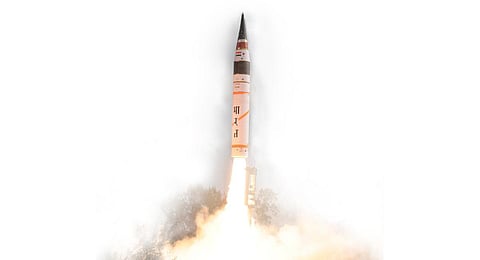

Ballistic missiles have changed the face of global warfare, shrinking the battlefield as a result. Brittanica defines a ballistic missile as “a rocket-propelled, self-guided strategic-weapons system that follows a ballistic trajectory to deliver a payload from its launch site to a predetermined target. Ballistic missiles can carry conventional high explosives as well as chemical, biological, or nuclear munitions”. The most potent form of this weapon is the Intercontinental Ballistic Missile (ICBM), boasting a range greater than 5,500 km, primarily designed for nuclear weapons delivery (thermonuclear warheads). Today, the US, Russia, China, India, France, the UK, Israel, and North Korea, are known to possess ICBMs, while a host of other nations do maintain arsenals of regular ballistic missiles.
Over the years, India has modernised its military capabilities, including developing robust missile deployment systems. According to reports, the country’s ground-based nuclear weapons programme comprises four operational ballistic missile systems and around 70 warheads. For instance, the short-range, road-mobile Prithvi-II and Agni-I (also rail-mobile) missiles can travel 250 km and 700 km, respectively. The DRDO has developed Agni-V, a land-based nuclear-capable ICBM, with a range of over 7,000 km, while carrying a payload of ~1,500 kg, at a speed of Mach 24 (29,401 kmph).
India is also part of the elite Nuclear Triad club. A nuclear triad is a three-pronged military force structure comprising land-launched nuclear missiles, nuclear-missile-armed submarines, and strategic aircraft carrying nuclear bombs and missiles.
Modern geopolitics has increased threat perceptions and impending hostilities, keeping most countries on edge. With the development of more effective ballistic missiles, countries are also creating stronger shields to preempt and intercept any potential missile attacks. Considering the speed, accuracy and unpredictability of these weapon systems, countries are aggressively building ballistic missile early warning systems.
India has heightened tensions with China and Pakistan. Over the years, several cross-border skirmishes have occurred, just short of escalating into full-blown conflicts. There have also been instances of missile attacks from across the borders. Accordingly, the Indian Ballistic Missile Defence Programme was launched in 2000 following the Kargil War, to deploy a multi-layered ballistic missile defence system to protect India from missile attacks.
Meanwhile, the country also operates the Prithvi Air Defence (PAD) system, an anti-ballistic missile developed to intercept incoming ballistic missiles outside the atmosphere. PAD is a two-stage missile with a maximum interception altitude of 80 km, capable of engaging 3,000-km class of ballistic missiles at Mach 5 (6,125.22 kmph). Also, the Indian Navy’s INS Dhruv is a platform with an active scanned array radar, through which it scans various spectra, monitors spy satellites and missile tests, and acts as an early warning system for enemy missiles aimed at urban areas and military installations. It can also track long-range nuclear missiles.
The country is also developing a three-layered long-range surface-to-air missile (LRSAM) defence system, geared to strike down enemy aircraft and missiles at a range of 400 km, in a major boost of defence indigenisation.